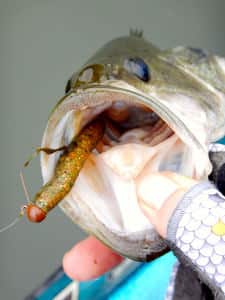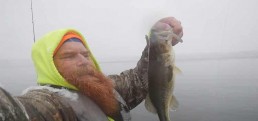Using the Ned Rig: Simple, Killer Bass System
SHARE THIS POST
A bass setup that swept across North America in 2015 is about as simple as a lure can get. It’s the “Ned Rig,” a small jighead with a straight, short, worm-shaped piece of soft plastic, 2-1/2 to 2-3/4 inches long. The Ned Rig bears the name of its inventor, retired Kansas fish biologist Ned Kehde, who also is a longtime outdoor writer specializing in bass topics.
If you’re reading this story in January, ice might have locked you out of your favorite bass waters. But the Ned will catch bass in any open water you can find right now—and be one of the most productive lures you can toss when the ice leaves this spring. In other words, add a few different colors and setups to your bass arsenal so you’re ready for open-water bass fishing. Heck, I bet you could go ice fishing with a Ned Rig and catch bass.
You can make a Ned Rig with any kind of soft plastic worm such as a Yamamoto Senko or a Yum Dinger—just cut the 5-inchers in half and thread the result on a jig. The “official” Ned Rig, however, employs either half of a 5-inch Z-Man Zinker Z or a whole T.R.D., which is molded specifically for the Ned. Both are made of Z-Man’s incredibly tough Elaztech plastic, which is super supple and pliable, yet will hold up to many, many fish.
I first saw the Ned Rig in action when my friend, writer Dave Mull, fished with me right after ice-out last spring. The bass world was already abuzz with news of this simple little lure’s ability to catch lots of fish, and Mull had a small supply of T.R.D. plastics that the folks at Z-Man Fishing (zmanfishing.com) had sent him to try out. The inside joke around the Z-Man community is the company dropped the “U” from the T.R.D. name, because the plastic lure looks like a Canada goose turd. But the initials T.R.D. stand for “The Real Deal,” and it really is the real deal for catching bass that are finicky because of high pressure systems, cold water—or lots of fishing pressure.
In fact, it’s whispered around the high-dollar tournament world that many big-time bass pros have a “turd box” safely stashed in their bass boats.
Mull and I were in my Nitro bass boat on a small Michigan lake in early April when Mull threw a T.R.D. in the “New Money” pattern (half green plastic with green glitter flake and half brown plastic with orange flake). He had rigged it on a 1/16-ounce Ozark Finesse Head in the green pumpkin color. On his first cast, he caught a little walleye. A few casts later he landed a small bass. Although the bigger baits I was throwing caught some fish, the Ned continued to hook up with bass of different sizes including a couple of 14-inch Michigan keepers—as well as a few bluegills and a crappie.
It was obviously a great lure for just plain getting the string stretched by whatever was in the lake—and something to add to my arsenal.
Are you enjoying this post?
You can be among the first to get the latest info on where to go, what to use and how to use it!
The most popular way to fish the Ned is on light, to ultra-light spinning gear, spooled with 8-pound test braided line (such as PowerPro) or fused line (such as Berkley FireLine Crystal, which is white and easy to see above the surface). Both of these lines are non-stretch, which makes it easy to feel a fish as soon as it engulfs your bait. To stealth these opaque lines up, add a 4-foot leader of 8-pound fluorocarbon; Seaguar AbrazX is hard to beat for its invisibility and resistance to abrasion. I like a rod that’s at least 7 feet long to facilitate long casts. Although it’s designed for trout fishing, the G. Loomis TSR 901-S-1 is a one-piece, 7’6” ultra-light rod that can fling small baits a country mile, but has enough backbone to keep fish out of weeds. You’re not going to want to flip to lily pads or blow-downs with this rod and 8-pound test line, but it’s great for covering big flats and taking long casts down drop-offs. Mull likes a 7-foot spinning rod from Lew’s, model MLS70, which is a medium-light, one-piece design originally designed for inshore fishermen seeking speckled sea trout.

You can fish the Ned Rig lots of ways. Anglers report success taking long casts and “swimming” it back by slowly reeling while shaking the rod tip to make the lure dart up and down while retrieved. Sometimes fish prefer to take the lure when you cast it out and let it settle to the bottom, twitching it back like it was a minnow or crawfish darting along over the sand or mud.
Another retrieve for fish up on shallow flats is a sort of “pump-swim” that lets the lure fall and dart. It’s simple to do. Just cast as far as you can, reel up the slack, pause and let the lure fall, pushing your rod tip toward the lure and creating slack in your line. Now pump the rod, quickly picking up the slack and making the lure jump. Reel up this slack, and point your rod toward the lure to let it fall and then pump the rod again. Most fish will hit as the lure falls and you’ll just feel some weight. Instead of setting the hook when you feel the weight, reel fast to load up the rod, and usually you’ll hook the fish.
Several different jigheads work with the T.R.D. Z-Man’s own ShroomZ Jigheadz are the easiest to rig in the tough Elaztech plastic that Z-Man uses—it has a small, sharp keeper that keeps the lure in position behind the head without needing super glue. Gopher Mushroom Heads, and the Ozark Finesse Head are two other heads that match up well with the T.R.D. Gamakatsu’s Round 211 model jighead works well, although the shank of its No. 2 hook is on the short side. Mull told me his favorite jig is the Ozark Finesse Head in 1/16-ounce, with a slightly pricier No. 1 Gamakatsu hook replacing the standard Mustad No. 2 hook. Since this jig head has no collar, you must add a drop of super glue gel to keep the plastic in position. Kansan David Reeves makes these Ozark Finesse Heads; you can order them by emailing dtrs5kprs@yahoo.com.
A quick word about the Elaztech plastic: It’s amazingly tough—you can stretch a 2-3/4-inch T.R.D. about 24 inches (seriously, try it) without it breaking. You can catch 20 or more fish on one without needing to replace it. Be careful, though, because this unique plastic compound reacts horribly with standard soft plastics. Store the two different kinds in the same tackle tray and you’ll end up with a melted, crunchy mess.
So, there’s your primer on the hot, new Ned Rig. If you have open water, give it a try now. If you must wait for ice-out, add a selection of T.R.D.s and some little jig heads to your bass arsenal and get ready for a bent rod this spring.
MWO
SHARE THIS POST
You may also like...
Nothing found.
Did you enjoy this post?
You can be among the first to get the latest info on where to go, what to use and how to use it!
Buck Mallory
Tournament angler and avid outdoorsman Buck Mallory of Lawton writes Michigan-specific bass fishing articles for MidWest Outdoors.
